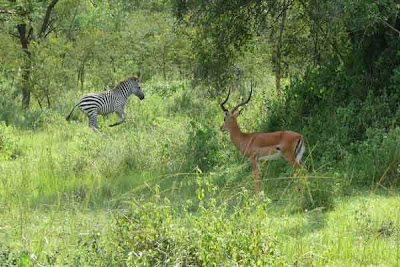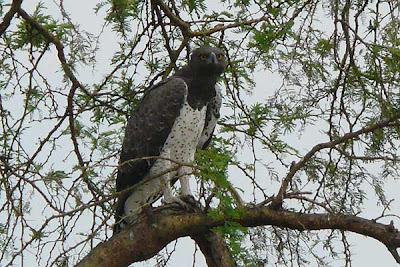We have been leading tours in Uganda for Avian Adventures for the last ten years. Sometimes we get to go there together but with small groups it only needs one of us and for the February tour it was June’s turn…
Once again Uganda didn’t disappoint! We had a marvellous tour finishing with totals of 436 bird species and, just as importantly, 33 mammals including wonderful experiences with Mountain Gorillas and Chimpanzees. We did have to work quite hard for some of our birds and that included the main attraction, the slightly bizarre but wonderful Shoebill. Thankfully, we eventually saw it really well (more on that later).
We flew to Uganda with KLM which enabled individuals to depart from regional airports in the UK and meet in Amsterdam for the onward flight to Entebbe. On arrival we were met at the airport by our driver Fred and local guide Robert, a team Peter and I have worked with regularly in the past, and taken to the Imperial Botanical Beach Hotel located at the edge of Lake Victoria. Apparently, US Presidents Clinton and Bush Jr have both stayed there in the past so we figure it’s OK for our first two nights of the tour.
The next morning, a gentle introduction to the country’s birds in the nearby Botanical Gardens and in the Entebbe Wildlife Education Centre produced many species that would become very familiar over the next two weeks. These included African Fish Eagle, Pied and Woodland Kingfishers, Broad-billed Roller and several species of waders and weavers. For the uninitiated, the variety of weaver species, in particular, presents something of a challenge at this stage in a tour! The water level in Lake Victoria was very high and everywhere was lush and green - not really what we have come to expect at this time of the year. There had obviously been a tremendous amount of rain and it was clear from the start that the unusual weather would be a significant factor on this tour.
Our second day was devoted to searching for Shoebill, ‘the must see bird’ of any Uganda trip. We set off for Mabamba at just after 6.00am as Fred was worried about the muddy state of the roads. And sure enough we were held up on the way by a truck which was stuck in a deep rut. Fred’s expert driving got us past the blockage only with some difficulty and we were delayed half an hour. Not a great start and when we reached our destination Haddington and his fellow boatmen were ready and waiting for us.
Soon we were heading off into the swamp where Long-toed Lapwing, Winding Cisticola, Malachite Kingfisher and Lesser Jacana were quickly on our list as we searched to no avail for a Shoebill. There are said to be just nine of these extraordinary birds at Mabamba and there is never any guarantee of finding them. Major problems are the impenetrable nature of the swamp and the height of the vegetation, which gives the birds plenty of places to hide away out of view. Add to those difficulties this time the fact that the unusually high water level had driven them much deeper than normal into the swamp and it started to look as though this trip might be our first not to see them. After four hours it was with great disappointment that we headed back to the shore.
Lunch was a sombre affair but we hadn’t reckoned on Haddington’s determination to find our bird. Unbeknown to us he had returned to the swamp in a smaller more manoeuvrable boat and managed to locate a Shoebill. We didn’t need persuading to go out with him again and were soon heading into some really dense vegetation. Haddington and his helper pushed and pulled the boat to get us as close as they could to the bird and we were finally rewarded for their efforts with a distant view of a Shoebill. Within minutes the bird decided to fly but that gave us wonderful views as it headed off deeper into the swamp. Mission accomplished thanks to Haddington!!
Our journey south from Kampala across the Equator to Mbarara was frustratingly almost entirely on a road that is currently under construction. Long-crested Eagles and Grey-backed Fiscals were easily identified as we drove along but there was little opportunity to actually stop for birds. At the Equator, Violet-backed Starling, Sooty Chat, Grey Woodpecker, African Green Pigeon, Red-headed Lovebird and Brown Parrot were noted.
We sat under a tree by a freshwater lake to eat our picnic lunch. African Spoonbill, Sacred Ibis, Knob-billed, White-faced and Fulvous Whistling Ducks, Wahlberg’s Eagle and Black-chested Snake Eagle were just a few of the birds seen there. Then we took the wet and muddy road into Lake Mburo National Park - Greater Painted-snipe, Water Thick-knee and Wood Sandpipers were along the roadside! Now we started to see some mammals: Eland, Impala, Warthogs, Waterbuck, Zebras and Hippos. Lush vegetation and the high water level proved a challenge when we set off for a walk but we had great views of Rufous-bellied Heron, Pin-tailed Whydah, Little Bee-eater, African Black-headed Oriole and more.
After a night in Mbarara we travelled on to Bwindi where one of the highlights of the tour is tracking Mountain Gorillas through the Impenetrable Forest. The journey there took us through Ruhiza which offers really first class forest birding. Year after year we arrive late at the camp in Bwindi because we have been so reluctant to leave Ruhiza. Today’s highlights included Mountain Buzzard, Auger Buzzard, Black and Cinnamon-chested Bee-eaters, Grey-throated Barbet, Grey Cuckoo-shrike, Snowy-headed Robin-chat, Mountain-masked and Chestnut-throated Apalises, Mountain Yellow Warbler, Regal Sunbird and Stripe-breasted Tit, all seen well.
Tracking Gorillas can sometimes be quite an arduous experience but our group enjoyed a reasonably easy time and spent a wonderful hour in the company of these fantastic animals. That allowed us the afternoon for flufftail hunting,. Flufftails are notoriously difficult to see but this is Robert’s home patch and I was confident he would find both Red-chested and White-spotted Flufftails for us. It was a most satisfying afternoon as we achieved both our targets without getting too muddy.
The birding in the forest here is second to none and we enjoyed a full day seeing such gems as Black-billed Turaco, Bar-tailed Trogan, White-headed Wood-hoopoe, African Broadbill, Hairy-breasted Barbet, Petit’s Cuckoo-shrike, White-tailed Crested Flycatcher and the list just kept getting longer. We even managed brief glimpses of a Gorilla family who were foraging not far from the track. A Golden Cat which shot across the trail in front of us perhaps in pursuit of one of the Duikers we had seen a little earlier proved a very rare sighting.
Once again the boys at Lake Kitandara Tented Camp looked after us wonderfully and we were sad to leave but Queen Elizabeth National Park beckoned. The drive there confirmed again that the rainfall this year was exceptional. Lush, tall grass was everywhere. Not only would spotting larks and pipits prove difficult but Buffalos might prove problematical too!
We arrived at Mweya Lodge in time for a quick lunch before heading to the jetty for the afternoon boat trip along the Kazinga Channel. This boat trip is one of the best in Uganda and for the next two hours we cruised along the shore spotting birds and mammals. Five Little Terns or Saunder’s Terns (the two species are impossible to tell apart outside the breeding season) were an unexpected find along the shore. I can’t see that either of them have been recorded before in Uganda. Other highlights were African Skimmers, Collared Pratincole, Black-tailed Godwit, Little Stint and Kittlitz’s Plover plus many herons, egrets, storks, terns, gulls, Elephants, Hippos, and Buffalos.
An evening walk on the airfield had to be cut short as a large herd of Buffalos were grazing there. Numerous hirundines and swifts wheeled overhead and we did manage to see Senegal, Crowned and African Wattled Lapwings and Southern Red Bishop before deciding it would be best not to risk tangling with what are reputed to be Africa’s meanest critters!
The next two days were spent birding out in the National Park, mostly from our vehicle but sometimes walking where it was safe to do so. Along the Kasenyi track a perched Martial Eagle was spotted and Short-toed Eagle, Montagu’s Harrier, European Bee-Eater, Yellow-throated Longclaw and African Crake were all seen well. A rainy afternoon was spent exploring along the bumpy tracks in the Kikorongo Crater area where two more Martial Eagles, a superb male Pallid Harrier and a Black Coucal were seen.
Much of one day was spent visiting Maramagambo Forest. On the way there we stopped at Kyambura Gorge where we got our first distant view of Chimpanzees. Also on the journey we came across a tree full of vultures and were able to identify White-backed, Palm-nut, Rüppell’s Griffon, White-headed and Hooded Vultures all waiting for their share of a nearby carcass. We walked part of the track into the forest and saw Sulphur-breasted Bush-shrike, Red-shouldered Cuckoo-shrike, Buff-fronted Warblers, Tropical Boubou, at least five Cardinal Woodpeckers, Least Honeyguide, Yellow-fronted Canary and Fawn-breasted Waxbills. We also had great views of two White-headed Barbets in a fruiting fig tree.
Unfortunately, our visit to the forest had to be cut short when torrential rain set in and Fred again became concerned about the state of the road. With much sliding and wheel spinning we eventually made it back onto the tarmac and rounded off the day with marvellous views of Papyrus Gonolek and Carruther’s Cisticola near Katunguru bridge where huge flocks of hirundines were feeding over the water.
More about my Uganda tour will follow soon…
Subscribe to:
Post Comments (Atom)
















No comments:
Post a Comment